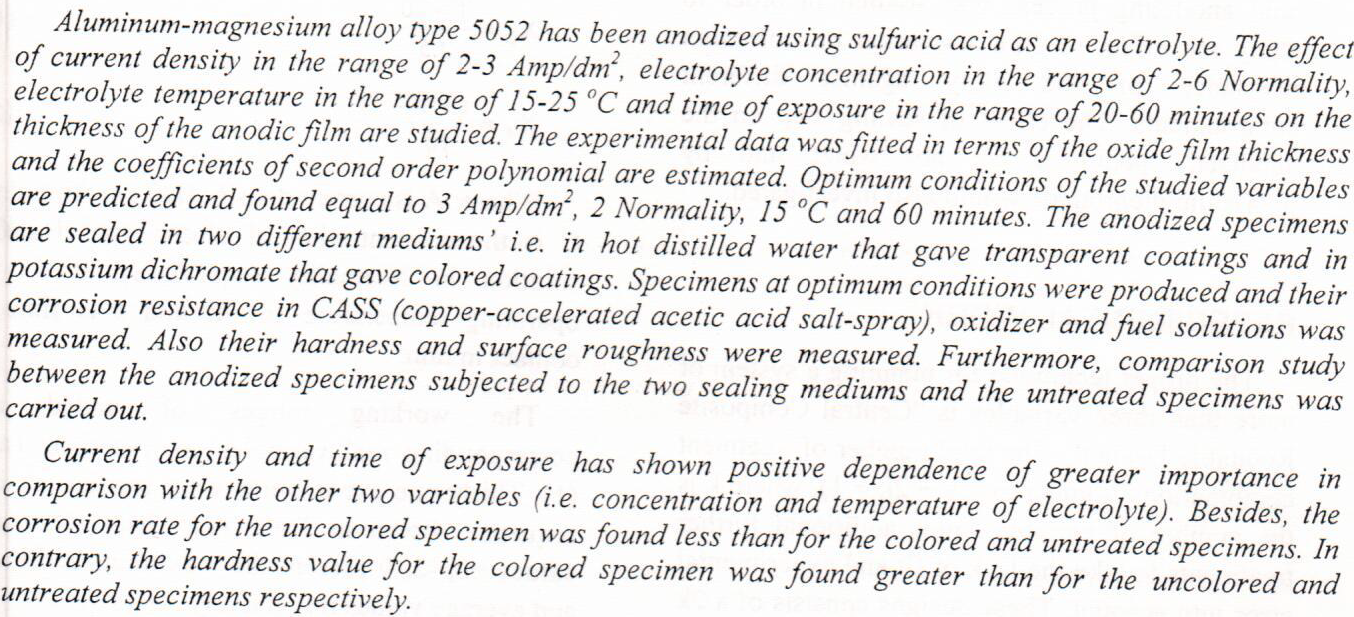
The ability of using aluminum filings which is locally solid waste was tested as a mono media in gravity rapid filter. The present study was conducted to evaluate the effect of variation of influent water turbidity (10, 20and 30 NTU); flow rate(30, 40, and 60 l/hr) and bed height (30and60)cm on the performance of aluminum filings filter media for 5 hours run time and compare it with the conventional sand filter. The results indicated that aluminum filings filter showed better performance than sand filter in the removal of turbidity and in the reduction of head loss. Results showed that the statistical model developed by the multiple linear regression was proved to be
valid, and it could be used to predict head loss in aluminum filings
Abstract: When it comes to applications in welding, cutting, and surface engineering, the utilization of high-power fiber-delivered beams from solid-state lasers offers several benefits. This paper addresses the issue of cleaning the surface of the samples with different spot sizes (50, 100 and 200) (industrial ytterbium fiber laser) to prepared it to be welded. Angular laser cleaning with incident angles (5, 10, 15, 20, 25, 30) ° with different powers (3, 5, 7, 10) W and hatch distance 0.001 was use for implemented.
In this study, aluminum nanoparticles (Al NPs) were prepared using explosive strips method in double-distilled deionized water (DDDW), where the effect of five different currents (25, 50, 75, 100 and 125 A) on particle size and distribution was studied. Also, the explosive strips method was used to decorate zinc oxide particles with Al particles, where Al particles were prepared in suspended from zinc oxide with DDDW. Transmission electron microscopy (TEM), UV-visible absorption spectroscopy, and x-ray diffraction are used to characterize the nanoparticles. XRD pattern were examined for three samples of aluminum particles and DDDW prepared with three current values (25, 75 and 125 A) and three samples prepared with the same currents for zin
... Show MoreSlag of aluminum is a residue which results during the melting process of primary and secondary aluminum production. Salt slag of aluminum is hazardous solid waste according to the European Catalogue for Hazardous Wastes. Hence, recovery of aluminum not only saves the environment, but also has advantages of financial and economic returns. In this research, aluminum was recovered and purified from the industrial wastes generated as waste from both of State Company for Electrical and Electronic Industries (Baghdad/AlWaziriya) and General Company for Mechanical Industries (Babylon/-Al-Escandria). It was found that these wastes contain tiny proportions of other elements such as iron, copper, nickel, titanium, lead, and potassium. Wastes were
... Show More (3)
(3)
Vitamin D is one of several nutrients essential for calcium metabolism. Body weight status and magnesium may influence vitamin D activity. To determine whether salivary vitamin D, magnesium, and calcium levels are associated with body weight status and dental caries severity in children, this cross‐sectional research was conducted.
The sample consisted of 180 boys aged 6–8 years. According to their body mass index (BMI), children were assigned to three groups of 60 boys (normal weight, overweight, and obese). Moreover,
The effects of shot peening treatment (SPT) were studied at (10,20, and 30) minutes on the rotating bending fatigue behavior and the behavior of the alloy steel DIN 41Cr4 vibrations. The hardness test, tensile test, constant amplitude fatigue tests, and the vibration measurements were performed on samples with and without cracks at room temperature (RT), also, the fracture surface was examined and analyzed by a Scanning Electron Microscope (SEM). The results of the investigations, for example, Stress to Number of cycles to failure (S-N) curves, fatigue strength improvement factor of 5% to 10%, the decreasing percentage of maximum Fast Fourier Transform (FFT) acceleration of the shot-peened condition were compared to untr
... Show More (1)
(1)
Titanium alloy (Ti-6Al-4V) samples were nitrided in low pressure (1.3, 3 mbar) dc-glow discharge plasmas of nitrogen. The treating time was 5, 10 and 15 hour and the temperatures range of the samples during the nitriding process was close to 800oC. The obtained microstructures of the nitride layers were studied by x-ray diffraction and optical microscopy. The ε –Ti2N, ζ-Ti3N3-x and η-Ti3N2-x.phases were formed and addition to the solid solution of nitrogen in titanium, α (Ti,N). Micro hardness measurements exhibit an increment for the Ti-alloy specimens which nitrided at 800oC for 10 and 15h.Corrosion measurements were obtained for the Ti-6Al-4V alloy in Ringer solution after plasma nitriding. The clear improving in the corrosion r
... Show MoreIn this study many specimen s were prepared from 2024-T3 Aluminum alloy for corrosion test by the dimensions of (15*15*3) mm according to ASTM G71-31 and then subjected to shot peening process at different time (15, 30, 45) minutes using steel ball having a diameter of 2.75 mm and Rockwell Hardness of 55RC to induce compressive residual stress which were measured using X-Ray diffraction method, surface roughness and hardness were tested before and after peening. Electrochemical corrosion test by Tafel extrapolation method was carried out in an environment of 3 .5% NaCl solutions (sea water) where Corrosion rate calculated using Tafle equation.
The obtained results show a favorable influence of SP treatment
... Show MoreFriction stir welding (FSW) of Tee-joints is obtained by inserting a specially designed rotating pin into the clamped blanks, through top plate (skin) to bottom plate (stringer), and then moving it along the joint, limiting the contact between the tool shoulder and the skin. The present work aims to investigate the defects occur for Tee-joint of an Aluminum alloy (Al 5456) with dimensions (180mm x 70mm) for the skin plate, (180mm x 30mm) for stringer plate and thickness of (4mm).
The effects of welding parameters such as rotational speed, linear speed, plunging depth, tool tilting, and die radii of welding fixture on the welding quality of Aluminum Alloy will be studied. Weld defects had been summarized and studied, and then the best
 (3)
(3)
